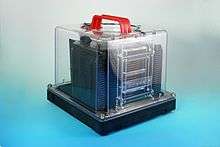SMIF (interface)

Acronym for Standard Mechanical InterFace. This is a SEMI standard, E19-1105.
An isolation technology developed in the 1980s by group known as "micronauts" at Hewlett-Packard in Palo Alto. The system is used in semiconductor wafer fabrication and cleanroom environments. The core team was led by Ulrich Kaempf as the engineering manager, under the direction of Mihir Parikh. The core team that developed the technology was driven by Barclay Tullis, who held most of the patents, with Dave Thrasher who later joined the Silicon Valley Group, and Thomas Atchison a member of the technical staff under direction of Barclay Tullis. Mihir later provided the technology to SEMI, and then licensed a copy for himself, and spun out Asyst Technologies to provide the technology commercially.
Its purpose is to isolate the wafers from contamination by providing a mini environment with controlled airflow, pressure and particle count. The concept was based upon the quantum mechanical principal of a particle in a box, and if you could isolate a single particle in a specific air volume, then you could apply physical principles to bias the particle to statistically not be located on the wafer. SMIF Pods can be accessed by automated mechanical interfaces from production equipment. The wafers therefore remain in a carefully controlled environment whether in the SMIF pod or in a tool, without being exposed to the surrounding airflow.
Each SMIF pod contains a wafer cassette in which the wafers are stored horizontally. The bottom surface of the pod is the opening door, and when a SMIF pod is placed on a load port, on example being the PLM-200 by Fortrend Engineering, the bottom door and cassette are lowered into the tool so that the wafers can be removed.
Note that both wafers and reticles can be handled by SMIF pods in semiconductor fabrication environment. Used in Lithographic tools, reticles or photomasks contain the image that is exposed on a coated wafer in one processing step of a complete integrated semiconductor manufacturing cycle. Because reticles are linked so directly with wafer processing, they also require steps to protect them from contamination or being the source of contamination in the litho tool. One example of a reticle SMIF pod is the Entegris RSP-150.
SMIF is typically used for wafers no larger than 200mm, the equivalent for 300mm wafers being the FOUP (Front Opening Unified Pod). The greater flexibility of 300mm wafers means that it is not feasible to use SMIF technology and designs for 300mm, hence the reason for the emergence of FOUPs. Several FOUP SEMI standards, including SEMI E47.1-1106, are related to both 300 and 450 mm wafers.
See also
External links
- Semiconductor Equipment and Materials International - SEMI the semiconductor industry trade association
- Entegris wafer and reticle handling systems
- Fortrend Engineering